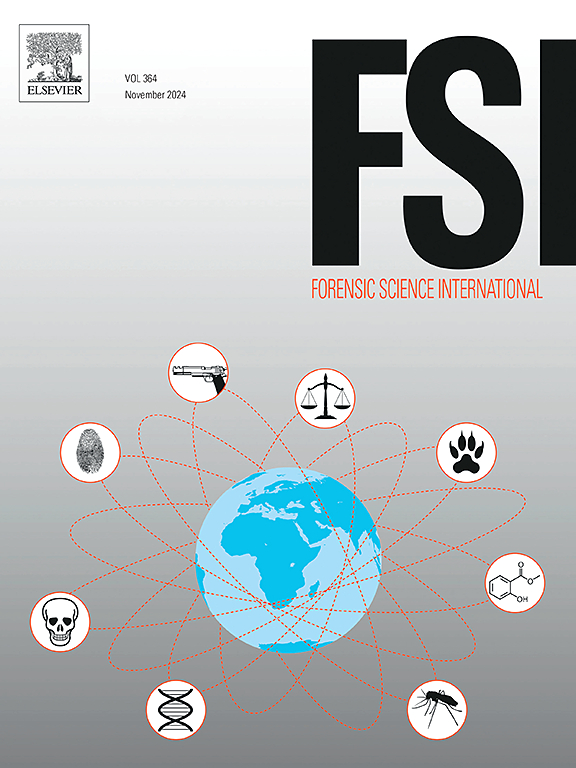Where did they come from? The accumulation of fibres from the home environment on daily wear
IF 2.5
3区 医学
Q1 MEDICINE, LEGAL
引用次数: 0
Abstract
Forensic fibre comparisons are not limited to the fibres from garments purported to have been worn during or involved in the incident. They extend to potential secondarily or higher order transferred fibres originating from textiles in frequented environments. Comparisons in these cases may be made to recovered known textiles, or to other fibre collectives found in the environment and clothing of the involved individuals. The results of such comparisons have been purported to be valuable due to several assumed axioms. First, that the fibre population of an environment is highly characteristic. Second, that these fibres reliably accumulate onto everyday wear from day-to-day activities in these environments. Finally, that these fibres accumulate in significant enough quantities to form a pool of fibres that can be transferred again in meaningful quantities. This study addresses these assumptions by studying the accumulation of fibres from home environments on daily wear. 24 participants were recruited to submit clothing worn in their home. These clothes were taped and examined with microscopy to evaluate the diversity of fibre populations of different homes. Following this, 5 of these 24 participants participated in a longitudinal study where target fibres were identified from their first submission. Potential origins of these target fibres were searched for in their homes and compared with fibres recovered from the submitted clothing. Undifferentiated known materials were then used to access the intra-variability of the target fibres. Meanwhile these 5 participants continued to submit clothing of their own along with clothing provided to them over the course of 5 – 6 months. These were also taped and examined with microscopy to assess the quantity of these target fibres. The results provided support for the three mentioned assumptions, which strengthens the case for carrying out such comparisons in practice. Furthermore, the data could be reliably modelled with a negative binomial linear regression based on factors such as shedding, use, and storage. Such models allow for more robust evaluation of scientific findings in fibre comparison cases of related nature.
它们是从哪里来的?日常穿着时来自家庭环境的纤维积累
法医纤维比较并不局限于声称在事件期间或涉及事件期间穿过的衣服的纤维。它们延伸到来自频繁使用环境的纺织品的潜在二级或更高阶转移纤维。在这些情况下,可以与回收的已知纺织品进行比较,或与在环境和有关个人的衣服中发现的其他纤维集体进行比较。由于几个假定的公理,这种比较的结果被认为是有价值的。首先,环境中的纤维种群具有高度的特征。其次,在这些环境中,这些纤维会在日常活动中积累到日常穿着上。最后,这些纤维以足够大的数量积累,形成一个纤维池,可以再次以有意义的数量转移。本研究通过研究来自家庭环境的纤维在日常穿着中的积累来解决这些假设。研究招募了24名参与者,要求他们提交在家中穿过的衣服。这些衣服被粘在一起,用显微镜检查,以评估不同家庭纤维种群的多样性。在此之后,这24名参与者中有5人参加了一项纵向研究,从他们第一次提交的材料中确定目标纤维。在他们的家中搜索了这些目标纤维的可能来源,并与从提交的衣服中回收的纤维进行了比较。然后使用未分化的已知材料来获取目标纤维的内部变异性。与此同时,这5名参与者在5 - 6个月的时间里继续提交自己的衣服和别人给他们的衣服。这些纤维也被粘起来并用显微镜检查,以评估这些目标纤维的数量。结果为上述三个假设提供了支持,从而加强了在实践中进行此类比较的理由。此外,基于脱落、使用和储存等因素,可以用负二项线性回归对数据进行可靠的建模。这种模型允许在相关性质的纤维比较案例中对科学发现进行更有力的评估。
本文章由计算机程序翻译,如有差异,请以英文原文为准。
求助全文
约1分钟内获得全文
求助全文
来源期刊

Forensic science international
医学-医学:法
CiteScore
5.00
自引率
9.10%
发文量
285
审稿时长
49 days
期刊介绍:
Forensic Science International is the flagship journal in the prestigious Forensic Science International family, publishing the most innovative, cutting-edge, and influential contributions across the forensic sciences. Fields include: forensic pathology and histochemistry, chemistry, biochemistry and toxicology, biology, serology, odontology, psychiatry, anthropology, digital forensics, the physical sciences, firearms, and document examination, as well as investigations of value to public health in its broadest sense, and the important marginal area where science and medicine interact with the law.
The journal publishes:
Case Reports
Commentaries
Letters to the Editor
Original Research Papers (Regular Papers)
Rapid Communications
Review Articles
Technical Notes.
 求助内容:
求助内容: 应助结果提醒方式:
应助结果提醒方式:


